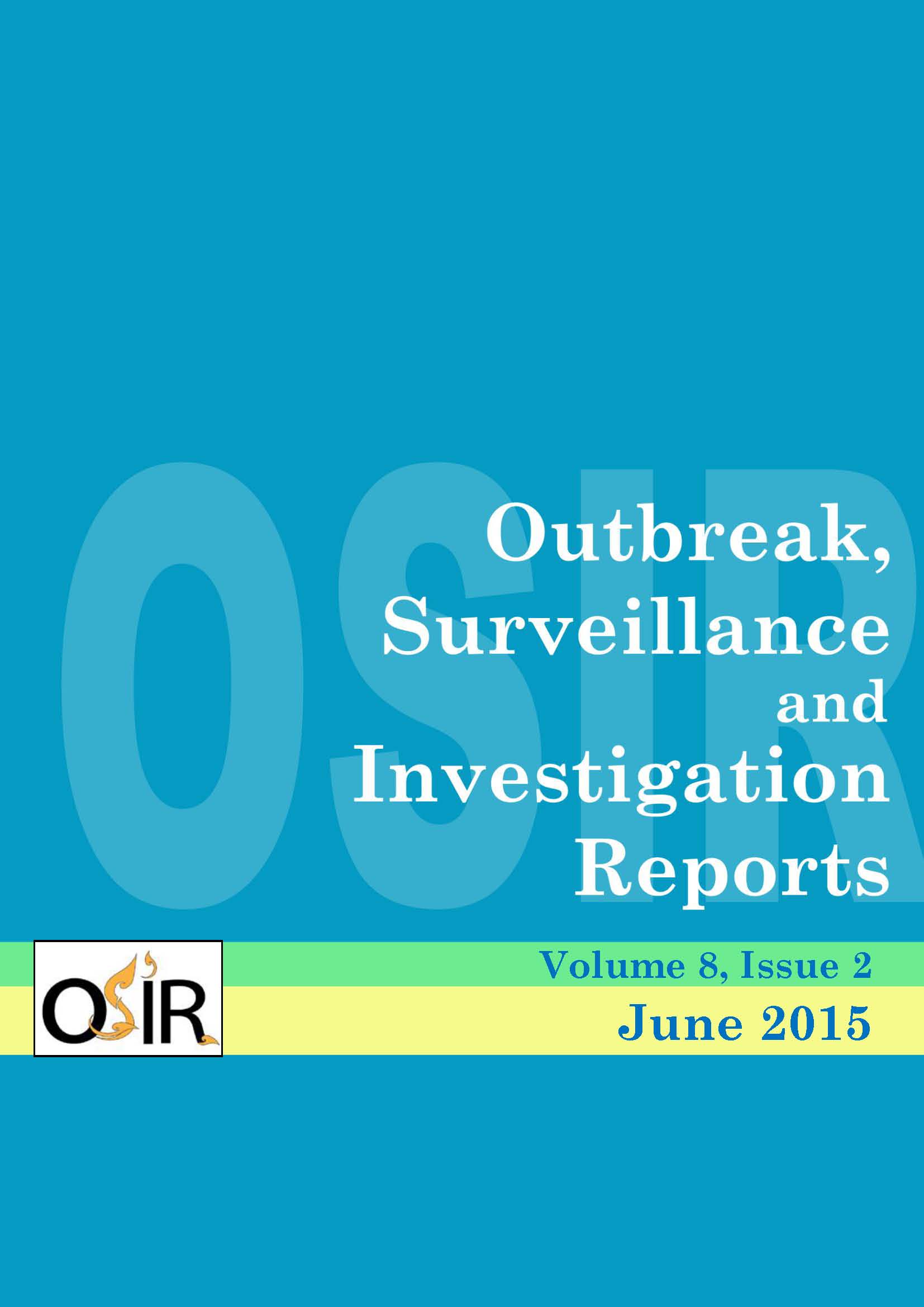Polio Seroprevalence in Thailand: Assessment of Outbreak Risk by Age Cohorts
DOI:
https://doi.org/10.59096/osir.v8i2.263276Keywords:
polio, sero-surveillance, immunity, population, ThailandAbstract
We conducted a serological survey to evaluate the population’s antibody level against three types of polio virus and identify high risk groups. We analyzed stored serum samples from a hepatitis immunity study conducted in 2004 on people born between 1928 and 2004. These samples were categorized into nine age cohorts and selected by random sampling. Antibody titers were tested by micro-neutralization. A protective level was defined as greater than 1:8. Protective antibody level against poliovirus and geometric mean titer (log2 reciprocal) were described by types of polio virus in the vaccine and birth cohorts. A total of 1,712 samples were tested. Protective antibody level against poliovirus type 1 was 90.9% while that of type 2 was 94.7% and type 3 was 83.9%. Means titers were 6.0 for type 1, 6.7 for type 2 and 4.9 for type 3. In the different birth cohorts, the antibody levels were the lowest against poliovirus type 2 (89.9%) in those who were born during 1955-1964. For poliovirus types 1 and 3, percentages in the 1975-1984 birth cohorts were less than 80%. Protective antibody level against the three types of poliovirus among the population in Thailand was assumed to be sufficient to generate herd immunity. People born during 1975-1984 were at risk and should be targeted for immunization if a polio outbreak occurred.
References
Hamborsky J, Kroger A, Wolfe S, editors. Epidemiology and prevention of vaccine-preventable diseases. 13th ed. Washington D.C: Public Health Foundation; 2015. p. 297-310 [cited 2015 Feb 2]. <http://www.cdc.gov/vaccines/pubs/pinkbook/polio.html#features>
Centers for Disease Control and Prevention. Updates on CDC’s polio eradication efforts. 2015 Apr 10 [cited 2015 Apr 22]. <http://www.cdc.gov/polio/updates/>
Centers for Disease Control and Prevention. Polio and polio vaccine. 2012 [cited 2015 Apr 7].
History of immunization in Thailand. In: Chokpaiboonkit K, Trishnananda M, Chunsuttiwat S, Tharmaphornpilas P, editors. Vaccine and immunization 2007. Nonthaburi: Ministry of Public Health; 2007. p. 13-24.
Warinsathien P. Vaccine coverage of diphtheria, tetanus, pertussis and polio among 1-2, 2-3 and 5-6 years age. In: Tharmaphornpilas P, Ratchumroensuk A, editors. Vaccine coverage survey, Thailand 2008. Nonthaburi: Ministry of Public Health, Thailand; 2008. p. 33-8.
Birmingham ME, Aylward RB, Cochi SL, Hull HF. National immunization days: state of the art. J Infect Dis. 1997 Feb;175 Suppl 1:S183-8.
Yoocharoen P, Warinsathien P, Ratchumroensuk A, Ratchumroensuk P. Vaccination. In: Tharmaphornpilas P, editor. Polio Eradication Guideline. Nonthaburi: Ministry of Public Health, Thailand; 2005. p. 21-3.
World Health Organization. Polio lab network quarterly update. 2004 [cited 2015 Apr 22]. <http://www.who.int/immunization_monitoring/VolXIssue4Dec04.pdf>
Resurgence of wild poliovirus type 1 transmission and consequences of importation--21 countries, 2002-2005. Morb Mortal Wkly Rep. 2006 Feb 17;55(6):145-50.
MacInnis L. Polio afflicts child in Myanmar, vaccinations planned. Reuters. 2011.
Global Polio Eradication Initiative. Circulating vaccine-derived poliovirus (cVDPV) 2000-2013. 2013 [cited 2013 May 2]. <http://www.polioeradication.org/Dataandmonitoring/Poliothisweek/Circulatingvaccinederivedpoliovirus.aspx>
Chongsrisawat V, Yoocharoen P, Theamboonlers A, Tharmaphornpilas P, Warinsathien P, Sinlaparatsamee S, et al. Hepatitis B seroprevalence in Thailand: 12 years after hepatitis B vaccine integration into the national expanded programme on immunization. Trop Med Int Health. 2006 Oct;11(10):1496-502.
Tharmaphornpilas P, Yoocharean P, Rasdjarmrearnsook AO, Theamboonlers A, Poovorawan Y. Seroprevalence of antibodies to measles, mumps, and rubella among Thai population: evaluation of measles/MMR immunization programme. J Health Popul Nutr. 2009 Feb;27(1):80-6.
World Health Organization. Manual for the virological investigation of polio. Geneva: World Health Organization; 1997 [cited 2013 May 2].
Arya SC, Agarwal N. Reassessing the cutoff level for poliovirus antibody in patients after successful chemotherapy for leukemia or hematopoietic stem cell transplantation. Clin Infect Dis. 2007 Aug 1;45(3):397; author reply 398-9.
Thailand. Bureau of Policy and Strategy. Ministry of Public Health. Important health information. 2557.
Conyn-Van Spaendonck MA, de Melker HE, Abbink F, Elzinga-Gholizadea N, Kimman TG, van Loon T. Immunity to poliomyelitis in The Netherlands. Am J Epidemiol. 2001 Feb 1;153(3):207-14.
Diedrich S, Claus H, Schreier E. Immunity status against poliomyelitis in Germany: determination of cut-off values in International Units. BMC Infect Dis. 2002 Feb 6;2:2.
Sutter RW, Kew OM, Cochi SL. Poliovirus vaccine-live. In: Plotkin SA, Orenstein WA, Offit PA, editors. Vaccines. 5th ed. Philadelphia: WB Saunders; 2008. p. 631-85.
Kim HJ, Hwang S, Lee S, Kwon Y, Park K, Park YJ, et al. A national cross-sectional study for poliovirus seroprevalence in the Republic of Korea in 2012: implication for deficiency in immunity to polio among middle-aged people. BMC Infectious Diseases. 2015;15(164):1-7.
Diedrich S, Schreier E. Status of immunity against poliomyelitis. Polio serosurvey in 1993. Dtsch Med Wochenschr1995 Feb 24;120(8):239-44. German.
Gidding HF, Backhouse JL, Gilbert GL, Burgess MA. National serosurvey of poliovirus immunity in Australia, 1996-99. Aust N Z J Public Health. 2005 Feb;29(1):48-52.
Patriarca PA, Wright PF, John TJ. Factors affecting the immunogenicity of oral poliovirus vaccine in developing countries: review. Rev Infect Dis. 1991 Sep-Oct;13(5):926-39.
Frantzidou F, Diza E, Halkia D, Antoniadis A. A seroprevalence study of poliovirus antibody in the population of northern Greece. Clin Microbiol Infect. 2005 Jan;11(1):68-71.
Mastroeni I, Patti AM, Fabrizi A, Santi AL, Manduca AM, Vescia N, et al. Immunity status against poliomyelitis in persons 13-14 years old living in Rome. Vaccine. 1997 Apr-May;15(6-7):747-50.
Mas Lago P, Ramon Bravo J, Andrus JK, Comellas MM, Galindo MA, de Quadros CA, et al. Lessons from Cuba: mass campaign administration of trivalent oral poliovirus vaccine and seroprevalence of poliovirus neutralizing antibodies. Bull World Health Organ. 1994;72(2):221-5.
Apparent global interruption of wild poliovirus type 2 transmission. Morb Mortal Wkly Rep. 2001 Mar 30;50(12):222-4.
Sutter RW, John TJ, Jain H, Agarkhedkar S, Ramanan PV, Verma H, et al. Immunogenicity of bivalent types 1 and 3 oral poliovirus vaccine: a randomised, double-blind, controlled trial. Lancet. 2010 Nov 13;376(9753):1682-8. Epub 2010 Oct 25.
Downloads
Published
How to Cite
Issue
Section
License
Copyright (c) 2023 Outbreak, Surveillance, Investigation & Response (OSIR) Journal

This work is licensed under a Creative Commons Attribution-NonCommercial-NoDerivatives 4.0 International License.









